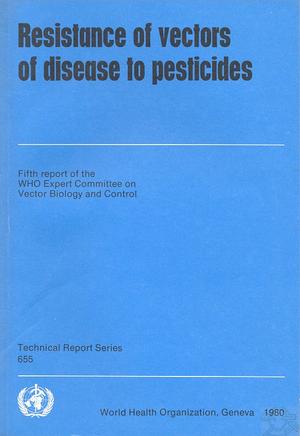Resistance of vectors of disease to pesticides
İÇİNDEKİLERCONTENTS 1. Introduction 2. Present status of resistance...................................... , 2.1 General considerations ................................... 2.2 Resistance in arthropod vectors.............................. 2.2.1 Anopheline mosquitos ................................ 2.2.2 Culicine mosquitos ................................... 2.2.3 Other arthropods of public health or veterinary importance 2.2.4 Nontarget organisms ..... ........................ 2.2.5 Resistance in reservoirs and intermediate hosts of disease . 3. Impact of pesticide resistance on the control of vectors and reservoirs of disease........ ................................................ 3.1 Impact on malaria vectors........... ............................ 3.1.1 The African Region ................. 3.1.2 The Region of the Americas................................... 3.1.3 The South-East Asia Region ................. 3.1.4 The European Region....................................... 3.1.5 The Eastern Mediterranean Region.................. 3.1.6 The Western Pacific Region .................................. 3.2 Impact on vectors of other diseases ................................. 3.2.1 Culicine mosquitos,.......................................... 3.2.2 Other vectors............................................. 3.3 Impact on disease reservoirs: rodents..................... .......... 3.4 General conclusions............................................... 4. Present status of research on resistance of vectors to pesticides ........ 4.1 Mosquitos .................................................. 4.2 Houseflies .................................................. 4.2.1 Pyrethroid resistance ................................... 4.2.2 Insect development inhibitors............................ 4.3 Ticks....................................................... 4.4 Biochemistry of resistance .................................... 4.4.1 Mixed function oxidases ................................ 4.4.2 Hydrolases, esterases and glutathione-dependent transferases 4.4.3 Reduced sensitivity of the nervous system ................. 4.4.4 Reduced sensitivity of acetylcholinesterase ................ 4.4.5 Additional preliminary biochemical studies on mosquitos 4.4.6 Resistance to insect development inhibitors................ 4.5 Genetics of resistance ................,....................... 4.5.1 Anopheles albimanus ................................... 4.5.2 Anopheles culicifacies................................... 4.5.3 Anopheles stephensi .................................... 4.5.4 Anopheles arabiensis ........................................ 4.5.5 Anopheles atroparvus........................................ 4.5.6 Culicines................................................... 4.5.7 Blatella germanica........................................... 4.5.8 Boophilus microplus......................................... 4.5.9 General conclusions ......................................... 5. Measures to counteract resistance....................................... 5.1 General......................................................... 5.2 Chemicals ....................................................... 5.2.1 Available chemicals ......................................... 5.2.2 New chemicals.............................................. - 5.3 Biological pesticides .............................................. 5.3.1 Serotype H-14 of Bacillus thuringiensis (or B. thuringiensis var. israelensis) ................................................. 5.3.2 Strain 1593 of Bacillus sphaericus (B. sph. 1593) ................ 5.4 Operational approaches ........................................... 5.4.1 Dosage management and the control of gene dominance ......... 5.4.2 Mosaic application of chemicals ............................... 5.4.3 Mixtures, rotation and optimum sequential usage of chemicals 5.4.4 Selective coverage........................................... 5.4.5 Environmental management.................................. 6. Detection and monitoring of vector resistance to pesticides................. 6.1 General considerations ............................................ 6.2 Detection of vector resistance ...................................... 6.2.1 Establishment and use of diagnostic concentrations .............. 6.2.2 Resistance detection surveys and their follow-up ................ 6.3 Monitoring vector resistance ....................................... 6.3.1 Monitoring objectives ....................................... 6.3.2 Monitoring strategy ......................................... 6.4 Test methods .................................................... 6.4.1 Mosquitos.................................................. 6.4.2 Lice, bedbugs, and fleas...................................... 6.4.3 Blackflies .................................................. 6.4.4 Triatominae ................................................ 6.4.5 Ticks ...................................................... 6.4.6 Molluscs ................................................... 6.4.7 Fish ....................................................... 6.5 Test kit components .............................................. 6.5.1 Adult mosquitos ........................................... 6.5.2 Mosquito larvae ........................................... 6.5.3 Midge larvae .............................................. 6.5.4 Lice...................................................... 6.5.5 Bedbugs .................................................. 6.5.6 Fleas ..................................................... 6.5.7 Sandflies and biting midges.................................. 6.5.8 Houseflies, tsetse flies, stable flies, and blowflies ...............6.5.9 Blackfly larvae 6.5.10 Supply........ 7. Dissemination of information and training .......... 7.1 Documentation and dissemination of information 7.2 Training.......... ......................... 8. Recommendations.................................................... References ............................................................. Acknowledgements...................................................... Annex 1. Insecticide resistance in anopheline mosquitos, culicine mosquitos, and other arthropod vectors..........................;............... Annex 2. Diagnostic dosages for the detection of resistance .................. Annex 3. Activities of FAO in connexion with resistance in agricultural pests to pesticides ...................................................    |



